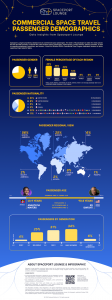US Dominates Space Passenger Data while Europe Lags on Gender
Exclusive Infographic Reveals Commercial Space Passenger Insights
It’s extraordinary to have such rich data on every passenger at the inception of a brand-new travel segment like commercial space travel. We look forward to sharing more fascinating insights ahead.”
SEATTLE, WA, UNITED STATES, October 8, 2024 /EINPresswire.com/ -- Spaceport Lounge, a leading space travel and lifestyle publication, has released an exclusive infographic revealing commercial space travel demographics that detail the characteristics of the first statistically significant set of private space passengers. — Bryan Estep, Founder, Spaceport Lounge
The data encompasses the first 116 commercial passengers (all passengers to date) who have crossed the FAA's 50-mile boundary or the 62-mile Kármán line, including self-funded spacefarers, invited guests, contest winners, industry travelers, and spaceline employees.
“It’s extraordinary to have such rich data on every passenger at the inception of a brand-new travel segment,” said Bryan Estep, founder of Spaceport Lounge. “We are excited to present this innovative visual as our first commercial space passenger infographic, and look forward to sharing even more fascinating insights ahead.”
Passenger Nationality
51% of all commercial space passengers are from the United States, followed by the United Kingdom (8%) and Italy (5%).
One explanation for US dominance is that the four leading space companies carrying commercial passengers to space are headquartered in the US – SpaceX, Axiom, Blue Origin, and Virgin Galactic (though Galactic’s primary shareholder, Virgin Group, is based in the UK).
Another factor is that all launch sites for these companies are located in the US as well – in Florida, Texas, and New Mexico – making logistics more convenient for US residents. The exception is Roscosmos, the first organization to carry paying passengers to space, dating back to 2001, but the Russian space agency’s passenger capacity is limited compared to the new commercial companies.
Passenger Gender
The majority of commercial space travelers are male, 72%, with females representing 28%.
Europe was the only region with a significant number of passengers that failed to meet the 28% female baseline, with just 14% of its space travelers being women. In contrast, Asia led in gender balance, with 43% of its passengers being female.
Short suborbital flights start at $450K, while longer orbital voyages to the International Space Station and beyond are now at $55 million, so cost is a factor likely impacting gender balance. When narrowing to the 57 passengers who paid their own way, according to the Spaceport Lounge database, we can see that only 13% of paying passengers are female, which is the same percentage of female billionaires on the planet according to a Forbes 2023 report.
For an in-depth understanding of commercial space travel alternatives, costs, and amenities, please consult our Commercial Space Travel Options overview.
Passenger Age
The average age of space travelers is 51 years old, with commercial space passengers ranging from 18.9 to 90.8 years old.
Anastatia Mayers, from Antigua, holds the record as the youngest spacefarer at 18.9 years old, while Ed Dwight, from the U.S., became the oldest spacefarer at 90.8 years old when he took that title earlier this year from actor William Shatner who was 90.6 years old at the time of his voyage.
As space tourism grows, Spaceport Lounge data and stories lead the way in delivering insights and breakthroughs in the industry.
Bryan Estep
Outbound Editions
email us here
Legal Disclaimer:
EIN Presswire provides this news content "as is" without warranty of any kind. We do not accept any responsibility or liability for the accuracy, content, images, videos, licenses, completeness, legality, or reliability of the information contained in this article. If you have any complaints or copyright issues related to this article, kindly contact the author above.

